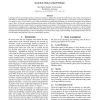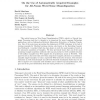11 search results - page 2 / 3 » Q-WordNet: Extracting Polarity from WordNet Senses |
LREC
2010
13 years 6 months ago
2010
Language users are increasingly turning to electronic resources to address their lexical information needs, due to their convenience and their ability to simultaneously capture di...
CIARP
2004
Springer
13 years 10 months ago
2004
Springer
We present a method for extracting selectional preferences of verbs from unannotated text. These selectional preferences are linked to an ontology (e.g. the hypernym relations foun...
JAIR
2008
13 years 5 months ago
2008
This article focuses on Word Sense Disambiguation (WSD), which is a Natural Language Processing task that is thought to be important for many Language Technology applications, suc...
MM
2010
ACM
13 years 5 months ago
2010
ACM
In this paper we study the connection between sentiment of images expressed in metadata and their visual content in the social photo sharing environment Flickr. To this end, we co...
LREC
2008
13 years 6 months ago
2008
We present the results of an agreement task carried out in the framework of the KNOW Project and consisting in manually annotating an agreement sample totaling 50 sentences extrac...


